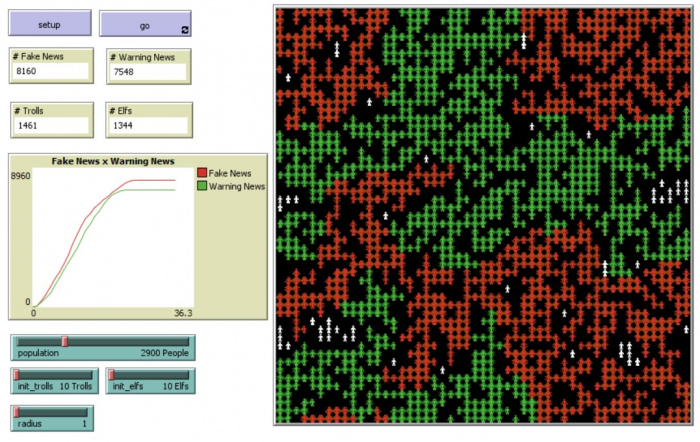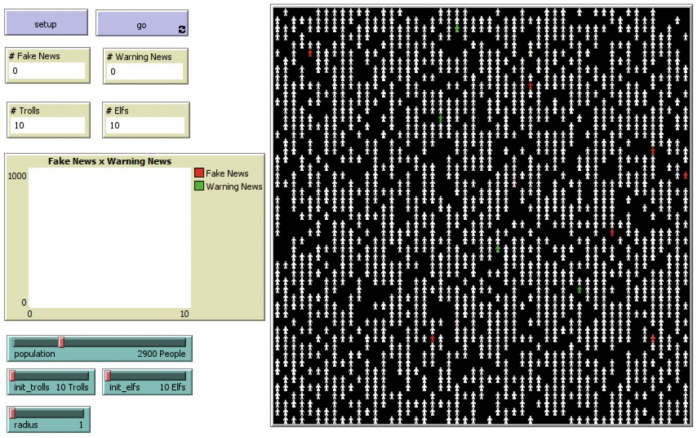Difference between revisions of "Is it possible to stop fake news"
(→Model) |
(→Scenario of simulation) |
||
| Line 39: | Line 39: | ||
==Scenario of simulation== | ==Scenario of simulation== | ||
The simulation begins with a population of people and a certain number of trolls and elfs. When the simulation starts running, trolls and elfs start to spread fake or warning news. As these news are spread, the basic population of people starts to emerge into elfs and trolls themselfs. The simulation can stop, when there is no changes in emergence of population and the numbers of trolls and elfs are stable. | The simulation begins with a population of people and a certain number of trolls and elfs. When the simulation starts running, trolls and elfs start to spread fake or warning news. As these news are spread, the basic population of people starts to emerge into elfs and trolls themselfs. The simulation can stop, when there is no changes in emergence of population and the numbers of trolls and elfs are stable. | ||
| + | |||
| + | |||
| + | [[File:Mart13-finished.jpg|700px|thumb|center| Finished simulation]] | ||
=User interface= | =User interface= | ||
Revision as of 13:43, 1 February 2022
NOT DONE YET, WORK IN PROGRESS
Name: Is it possible to stop fake news?
Author: Tomáš Martínek (mart13) (talk)
Method: MAS Simulation
Tool: NetLogo
Contents
Problem definition
Fake news is a global problem and it is getting worse every year. Is it possible to stop fake news? Fake news are made by people named "trolls". These trolls make fake news and send them to other people. On the other side of the table are elfs, who defend people from fake news and send "fake news warnings". When people receive fake news, they have basicaly three choices: resend it as it is (basicaly become troll), resend it with "fake news warning" (become elf) or dont resend it. Can elfs beat trolls and defend the majority of system from fake news?
The goal of this simulation is to find out what must happen to defend the majority of society from fake news.
Method
Simulation is creted in NetLogo software. I chose multi agent system aproach due to decentralization and autonomy of simulated environment.
Created MAS system consists of reactive agents. They only react to a few basic rules:
- If an agent has more fake news than warning news, agent becomes a troll and starts to send fake news to other people around.
- If an agent has more warning news than fake news, agent becomes an elf and starts to send warning news to other people around.
Model
Entities
Simulation model has technically only one entity, which is people. According to their properties I divide them into three groups:
- Trolls: was initiated as a troll or has more fake news than warnings at the moment.
- Elfs: was initiated as an elf or has more warnings than fake news at the moment.
- Basic people: people without any fake news or warning news.
Every group has a different colour and ability, trolls are red and can send fake news, elfs are green and can send warning news. Basic people are white.
It is a reflection of a real world situation, where there are only people too and according to their surrounding environment (family, friends, country they live, ...), they create their beliefs and opinions on the forthcoming news.
Relationships
The mechanism of sending fake and warning news is made of relationships between people. The simulation consists of two different relationship:
- Fake news relationship: a vizualization of sending a fake news from trolls
- Warning news relationship: a vizualization of sending a warning news from elfs
Scenario of simulation
The simulation begins with a population of people and a certain number of trolls and elfs. When the simulation starts running, trolls and elfs start to spread fake or warning news. As these news are spread, the basic population of people starts to emerge into elfs and trolls themselfs. The simulation can stop, when there is no changes in emergence of population and the numbers of trolls and elfs are stable.
User interface
Inputs, monitors and graphs
Overview
User inputs
Monitors and graphs
Results
Conclusion
Sources
- https://www.nytimes.com/2021/11/22/world/europe/belarus-migrants-facebook-fake-news.html
- https://semantic-visions.com/resource/defending-the-covid-19-vaccination-pipeline
- https://www.cits.ucsb.edu/fake-news/spread
- https://thenextweb.com/news/ai-isnt-going-to-stop-fake-news-syndication
- https://www.bbc.co.uk/bitesize/articles/z6kxxyc
- https://ischool.syr.edu/fake-news-why-people-believe-how-it-spreads-and-what-you-can-do-about-it/
- https://futurism.com/fake-news-study-spread

